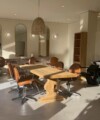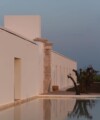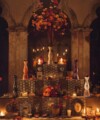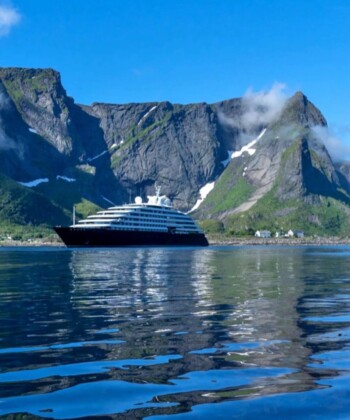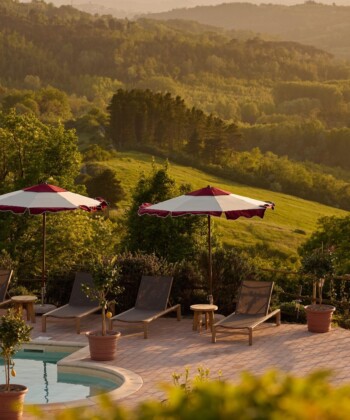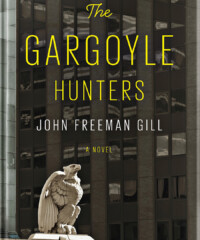It’s nearly midnight, and I’m in an empty ballroom with a bellboy. One room over, a solitary bartender polishes tumblers beneath a chandelier from Gone with the Wind. Downstairs in the casino, neon lights wink and whirl in time with bleeping slot machines, and somewhere below that, a 25-ton cement door guards the entrance to a labyrinth of rooms frozen in perpetual readiness for the nuclear apocalypse. Outside, the mountains of West Virginia loom in the darkness. If my life were an endlessly rolling indie film, I’d be certain that Wes Anderson directed this portion: A Weekend at The Greenbrier Hotel.
Located in West Virginia’s White Sulphur Springs, a town nestled in Appalachia’s Allegheny mountains, The Greenbrier’s sheer grandiosity—11,000 acres, 710 rooms (done in a decidedly non-minimalist style by interior designer Dorothy Draper in 1946)—is astounding. Upwards of 2,000 employees operate 20 dining and lounge venues, 38 retail shops, five golf courses, an expansive mineral spa, a bowling alley, a movie theatre, an Olympic-size indoor pool, and an outdoor infinity pool the size of a small lake. As Larry Klein, vice president of The Greenbrier Sporting Club, says, “Anything that doesn’t involve an ocean, we’ve got you covered.” The area’s geography is overpowering: mountains frame all entries to the resort. On site, adventurers can traverse 23 miles of rolling green highlands. Fish shimmer in babbling brooks; hawks cast their silhouettes against crisp blue skies. It’s a setting straight out of a John Denver song.
In 1778, travelers began coming to the Greenbrier Valley in the summer months to “take the waters,” or escape the heat of the city while luxuriating in the cool mountain springs. (The original hotel was built in 1858, and the current structure in 1930.) The next morning, after a breakfast among the majestic columns of the main dining room, I decide to adhere to this custom, and slip into my suite’s Jacuzzi-style bathtub to read up on the hotel’s history. Twenty-six presidents have visited. The last sitting one to make the trek was Dwight Eisenhower, who allegedly came for the golf but was more likely here to oversee construction of what has become The Greenbrier’s most fascinating contribution to American history: the Cold War bunker, a subterranean, post-WWII chamber designed as a relocation facility for Congress in the event of a nuclear attack on Washington. I deliberate the odds that Ike and I have “taken the waters” in the same tub.
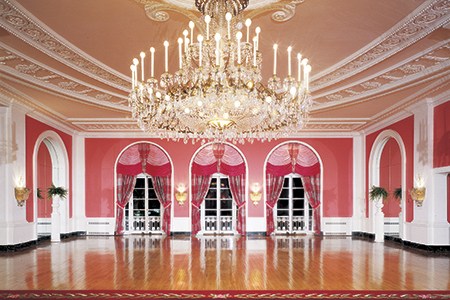
The Greenbrier resort’s Cameo Ballroom
Photo by Greenbrier County CVB.
Many describe the property as the feather in the cap of West Virginia. Since 2009, that cap has been resting on the head of Jim Justice, now the state’s governor. When the resort went bankrupt nearly a decade ago, Justice, a native coal mining and agriculture tycoon, bought the property and gave it a $350 million facelift. After his 2016 election he divested from the business, but his daughter Jill still runs its day-to-day affairs.
While much of The Greenbrier’s appeal is rooted in nostalgia, management continues to cast an eye to the future. Klein says they see The Greenbrier and its neighboring town of Lewisburg—a beacon of West Virginia’s arts community—as a harbinger for the state’s tourism industry. “We just need to get the word out,” he says. “There’s no reason White Sulphur Springs or Lewisburg couldn’t be the Vail of the East.”
Transforming a single resort into an international tourism hub requires investment in many areas, including real estate. That’s where The Greenbrier Sporting Club comes in: Launched in 2000, members pay an initiation fee of $120,000 and are also required to own property here. Today there are more than 400 private homes (pro golfers Bubba Watson and Phil Mickelson are among their owners).
After a last supper at Draper’s, the hotel’s bubble-gum pink, 50s ice-cream parlor eatery, I stroll the grounds, passing a romantic gazebo, and then stumbling upon a trail. I wander up and up, past cozily lit cottages and past clusters of elegant chalets. I climb higher, swallowing deep gulps of cool mountain air. Eventually I reach a small clearing overlooking the great white Greenbrier, unfurled across the valley below. I wonder how many have stood here before me, taking in the grandeur and the glamour, sad to the see the credits roll on A Weekend at The Greenbrier Hotel.





